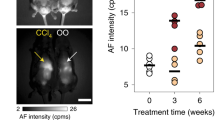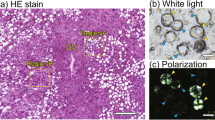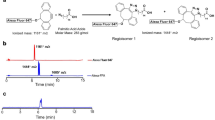Abstract
Excess lipid accumulation in peripheral tissues is a key feature of many metabolic diseases. Therefore, techniques for imaging and quantifying lipids in various tissues are important for understanding and evaluating the overall metabolic status of a research subject. Here we present a protocol that detects neutral lipids and lipid droplet (LD) morphology by oil red O (ORO) staining of sections from frozen tissues. The method allows for easy estimation of tissue lipid content and distribution using only basic laboratory and computer equipment. Furthermore, the procedure described here is well suited for the comparison of different metabolically challenged animal models. As an example, we include data on muscular and hepatic lipid accumulation in diet-induced and genetically induced diabetic mice. The experimental description presents details for optimal staining of lipids using ORO, including tissue collection, sectioning, staining, imaging and measurements of tissue lipids, in a time frame of less than 2 d.
This is a preview of subscription content, access via your institution
Access options
Subscribe to this journal
Receive 12 print issues and online access
$259.00 per year
only $21.58 per issue
Buy this article
- Purchase on Springer Link
- Instant access to full article PDF
Prices may be subject to local taxes which are calculated during checkout

Similar content being viewed by others
References
Samuel, V.T., Petersen, K.F. & Shulman, G.I. Lipid-induced insulin resistance: unravelling the mechanism. Lancet 375, 2267–2277 (2010).
Hagberg, C.E. et al. Targeting VEGF-B as a novel treatment for insulin resistance and type 2 diabetes. Nature 490, 426–430 (2012).
Unger, R.H. Lipotoxic diseases. Annu. Rev. Med. 53, 319–336 (2002).
Yu, C. et al. Mechanism by which fatty acids inhibit insulin activation of insulin receptor substrate-1 (IRS-1)-associated phosphatidylinositol 3-kinase activity in muscle. J. Biol. Chem. 277, 50230–50236 (2002).
Bostrom, P. et al. SNARE proteins mediate fusion between cytosolic lipid droplets and are implicated in insulin sensitivity. Nat. Cell Biol 9, 1286–1293 (2007).
Sollner, T.H. Lipid droplets highjack SNAREs. Nat. Cell Biol. 9, 1219–1220 (2007).
Kim, F. et al. Vascular inflammation, insulin resistance, and reduced nitric oxide production precede the onset of peripheral insulin resistance. Arterioscler. Thromb. Vasc. Biol. 28, 1982–1988 (2008).
Duncan, E.R. et al. Effect of endothelium-specific insulin resistance on endothelial function in vivo. Diabetes 57, 3307–3314 (2008).
Park, S.Y. et al. Unraveling the temporal pattern of diet-induced insulin resistance in individual organs and cardiac dysfunction in C57BL/6 mice. Diabetes 54, 3530–3540 (2005).
Ahmadian, M., Duncan, R.E. & Sul, H.S. The skinny on fat: lipolysis and fatty acid utilization in adipocytes. Trends Endocrinol. Metab. 20, 424–428 (2009).
Farese, R.V. Jr., Zechner, R., Newgard, C.B. & Walther, T.C. The problem of establishing relationships between hepatic steatosis and hepatic insulin resistance. Cell Metab. 15, 570–573 (2012).
Avramoglu, R.K., Basciano, H. & Adeli, K. Lipid and lipoprotein dysregulation in insulin resistant states. Clin. Chim. Acta. 368, 1–19 (2006).
Hagberg, C.E. et al. Vascular endothelial growth factor B controls endothelial fatty acid uptake. Nature 464, 917–921 (2010).
Spangenburg, E.E., Pratt, S.J., Wohlers, L.M. & Lovering, R.M. Use of BODIPY (493/503) to visualize intramuscular lipid droplets in skeletal muscle. J. Biomed. Biotechnol. 2011, 598358 (2011).
Falcon, A. et al. FATP2 is a hepatic fatty acid transporter and peroxisomal very long-chain acyl-CoA synthetase. Am. J. Physiol. Endocrinol. Metab. 299, E384–E393 (2010).
Bonilla, E. & Prelle, A. Application of nile blue and nile red, two fluorescent probes, for detection of lipid droplets in human skeletal muscle. J. Histochem. Cytochem. 35, 619–621 (1987).
Fowler, S.D. & Greenspan, P. Application of Nile red, a fluorescent hydrophobic probe, for the detection of neutral lipid deposits in tissue sections: comparison with oil red O. J. Histochem. Cytochem. 33, 833–836 (1985).
Fuchs, B., Suss, R., Teuber, K., Eibisch, M. & Schiller, J. Lipid analysis by thin-layer chromatography—a review of the current state. J. Chromatogr. A 1218, 2754–2774 (2011).
Fuchs, B., Suss, R. & Schiller, J. An update of MALDI-TOF mass spectrometry in lipid research. Prog. Lipid Res. 49, 450–475 (2010).
Ramirez-Zacarias, J.L., Castro-Munozledo, F. & Kuri-Harcuch, W. Quantitation of adipose conversion and triglycerides by staining intracytoplasmic lipids with Oil red O. Histochemistry 97, 493–497 (1992).
Levene, A.P. et al. Quantifying hepatic steatosis—more than meets the eye. Histopathology 60, 971–981 (2012).
Catta-Preta, M., Mendonca, L.S., Fraulob-Aquino, J., Aguila, M.B. & Mandarim-de-Lacerda, C.A. A critical analysis of three quantitative methods of assessment of hepatic steatosis in liver biopsies. Virchows Arch. 459, 477–485 (2011).
De Bock, K. et al. Evaluation of intramyocellular lipid breakdown during exercise by biochemical assay, NMR spectroscopy, and Oil Red O staining. Am. J. Physiol. Endocrinol. Metab. 293, E428–E434 (2007).
Shaw, C.S., Jones, D.A. & Wagenmakers, A.J. Network distribution of mitochondria and lipid droplets in human muscle fibres. Histochem. Cell Biol. 129, 65–72 (2008).
Olofsson, S.O. et al. Triglyceride containing lipid droplets and lipid droplet-associated proteins. Curr. Opin. Lipidol. 19, 441–447 (2008).
Fukumoto, S. & Fujimoto, T. Deformation of lipid droplets in fixed samples. Histochem. Cell Biol. 118, 423–428 (2002).
Zhou, J., Lhotak, S., Hilditch, B.A. & Austin, R.C. Activation of the unfolded protein response occurs at all stages of atherosclerotic lesion development in apolipoprotein E–deficient mice. Circulation 111, 1814–1821 (2005).
Pizzurro, G.A. et al. High lipid content of irradiated human melanoma cells does not affect cytokine-matured dendritic cell function. Cancer Immunol. Immunother. 62, 3–15 (2013).
Schneider, C.A., Rasband, W.S. & Eliceiri, K.W. NIH Image to ImageJ: 25 years of image analysis. Nat. Methods 9, 671–675 (2012).
Geerts, A. History, heterogeneity, developmental biology, and functions of quiescent hepatic stellate cells. Semin. Liver Dis. 21, 311–335 (2001).
Acknowledgements
We want to thank S. Wittgren, E. Cortez and C. Mössinger for technical assistance. This study was supported by The Novo Nordisk Foundation, The Swedish Cancer Foundation, The Swedish Research Council, Torsten och Ragnar Söderbergs Stiftelser, The Peter Wallenberg Foundation for Economics and Technology, The Swedish Heart and Lung Foundation, Ludwig Institute for Cancer Research and Karolinska Institutet. C.E.H. was kindly supported by Frans Wilhelm och Waldemar von Frenckells Fond and by Wilhelm och Else Stockmanns Stiftelse.
Author information
Authors and Affiliations
Contributions
A.M. performed in vivo mouse experiments, ORO analyses and wrote the paper; C.E.H. optimized the protocol and commented on the paper; L.M. commented on the paper; U.E. commented on the paper; A.F. optimized the protocol, performed ORO analyses, assisted in in vivo mouse studies and wrote the paper. All the authors discussed the results and commented on the manuscript.
Corresponding author
Ethics declarations
Competing interests
The authors declare no competing financial interests.
Rights and permissions
About this article
Cite this article
Mehlem, A., Hagberg, C., Muhl, L. et al. Imaging of neutral lipids by oil red O for analyzing the metabolic status in health and disease. Nat Protoc 8, 1149–1154 (2013). https://doi.org/10.1038/nprot.2013.055
Published:
Issue Date:
DOI: https://doi.org/10.1038/nprot.2013.055
This article is cited by
-
Comparative analysis of anti-obesity effects of green, fermented, and γ-aminobutyric acid teas in a high-fat diet-induced mouse model
Applied Biological Chemistry (2024)
-
Conjugated Linoleic Acid Reduces Lipid Accumulation via Down-regulation Expression of Lipogenic Genes and Up-regulation of Apoptotic Genes in Grass Carp (Ctenopharyngodon idella) Adipocyte In Vitro
Marine Biotechnology (2024)
-
An evaluation of a hepatotoxicity risk induced by the microplastic polymethyl methacrylate (PMMA) using HepG2/THP-1 co-culture model
Environmental Science and Pollution Research (2024)
-
Perilipin5 protects against non-alcoholic steatohepatitis by increasing 11-Dodecenoic acid and inhibiting the occurrence of ferroptosis
Nutrition & Metabolism (2023)
-
TREM2 deficiency inhibits microglial activation and aggravates demyelinating injury in neuromyelitis optica spectrum disorder
Journal of Neuroinflammation (2023)
Comments
By submitting a comment you agree to abide by our Terms and Community Guidelines. If you find something abusive or that does not comply with our terms or guidelines please flag it as inappropriate.



